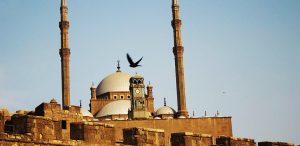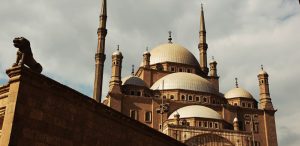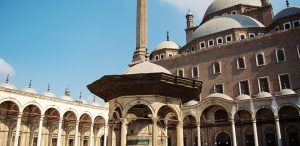+20 2 3762 0904 / +372 5923 9322 /
+44 745 225 4645
Introducción sobre La Ciudadela de Saladino
Establecida en el siglo XII d.C. por el famoso sultán árabe Saladino, la ciudadela es una de las fortalezas más impresionantes de la Edad Media.
Su presencia cobró mayor importancia cuando se convirtió en la sede de gobierno de Egipto. Hoy, constituye una de las excursiones más importantes de El Cairo, incluidas en casi todos los viajes a Egipto.
Ubicación Geográfica
Saladino eligió cuidadosamente la ubicación de su ciudadela. Temiendo los repetidos ataques de los Cruzados en Medio Oriente, mandó construirla en lo alto de una de las montañas de Moqattam, en El Cairo.
Se puede acceder a la Ciudadela de Saladino en taxi. Está cerca de otras atracciones como la Mezquita del Sultán Hassan y el Museo Egipcio. Sin embargo, la mayoría de los turistas que visitan Egipto prefieren reservar un paquete de viaje con alguna agencia local para así aprovechar al máximo su estadía.
Historia
La construcción de la Ciudadela de Saladino comenzó en el año 1176 d.C., cuando el sultán Saladino ordenó a su visir Bahaa’ El Din Karakosh que demoliera los edificios y tumbas que estaban ocupando el área en ese tiempo.
Los constructores tuvieron que excavar un túnel artificial entre la montaña de Moqattam propiamente dicha y el sector donde se construiría la ciudadela, a fin de dificultar el acceso a la misma.
Otra de las razones por las cuales Saladino eligió esta ubicación para construir la ciudadela, es por estar entre las dos capitales de Egipto en ese tiempo: El Fustat y El Cairo.
La fortaleza poseía una conexión con la ciudad y sería un lugar de refugio en caso de que los enemigos tomaran el control de El Cairo.
El sultán también ordenó la excavación de un pozo de agua para abastecer a los soldados. Esta fue una de las misiones más difíciles, ya que para llevarla a cabo se tuvo que hacer una perforación de más de 90 metros de profundidad en suelo rocoso.
Saladino no tuvo la oportunidad de ver realizado su proyecto, ya que falleció en 1193 d.C., y su visir recién completó la construcción en 1204. Su hermano, El Malek El Adel fue el primer rey residente en la ciudadela.
Descripción
La Ciudadela de Saladino constaba de dos secciones: la parte norte, utilizada como un fuerte militar, con grandes murallas fortificadas que custodiaban las direcciones norte y este y tenían pequeñas aberturas para permitir que los arqueros pudieran defenderla de cualquier ataque.
La segunda sección de la Ciudadela de Saladino, la parte sur, era la residencia del rey y albergaba un gran palacio. Sin embargo, esta sección fue transformada posteriormente y es muy poco lo que se conserva de las estructuras originales.
La Ciudadela de Saladino tenía varias puertas en sus murallas, para facilitar la entrada de los soldados y los visitantes que acudían a la fortaleza. Una de las puertas más importantes, es la Puerta Moqattam, establecida durante la era otomana. Hoy se llama Salah Salem, en referencia al nombre de la calle actual, y hoy en día es la principal entrada a la ciudadela.
Otra puerta importante es la Puerta Nueva, establecida por Mohamed Ali en 1827, para permitir que vehículos militares y cañones pudieran ingresar al fuerte. Esta puerta está ubicada cerca de Dar El Mahfozat, la Oficina Nacional de Archivos, situada al oeste de las murallas.
Entre las características más impresionantes de la ciudadela, está el pozo de agua Josef, por ser una pieza arquitectónica única. Consiste de dos profundos agujeros hechos en el suelo. Una de las salas es lo suficientemente grande para que los toros ingresaran y pudieran mover la noria situada en la sección más profunda del pozo, para elevar el agua a la superficie.
Desde que La Ciudadela de Saladino se convirtió en residencia de los gobernadores de Egipto, muchos de estos reyes y sultanes construyeron diferentes edificios dentro de ella, a lo largo del tiempo.
La Mezquita de Mohamed Ali
El lugar más destacado de la ciudadela es, sin duda, la Mezquita de Alabastro, construida por Mohamed Ali, hasta el punto de que la mayoría de la gente cree que la ciudadela es dicha mezquita.
Su construcción comenzó en 1830 y fue finalizada en 1849, siguiendo el estilo arquitectónico otomano, en un intento de competir con las mezquitas de Estambul.
Son notables sus maravillosos mármoles, que cubren casi todas las paredes interiores y los pisos; y su mihrab y minbar decorados en dorado.
La mezquita también alberga el mausoleo de su constructor, Mohamed Ali, y es una construcción de mármol, con una galería cubierta de cobre dorado. Fue diseñado con una mezcla de estilos islámicos y otomanos.
Qasr El Jawhara
Qasr El Jawhara o el “Palacio de Jawhara”, está situado en la parte suroeste de la ciudadela, y fue nombrado así por la esposa de Mohamed Ali: Jawhara. Este palacio consiste de dos pisos, de diseño sencillo, excepto por dos grandes espejos revestidos de oro en cada piso.
La parte más importante del palacio es la sala desde donde Mohamed Ali solía gobernar, que contiene su trono de oro.
Otra característica a destacar del palacio es que fue testigo de la famosa masacre en la cual Mohamed Ali asesinó a todos los mamelucos, luego de haberlos invitado a cenar.
Panorama de El Cairo
La sección sur de la ciudadela se caracteriza por estar situada en la parte más alta y ofrecer magníficas vistas de El Cairo. En uno de los miradores, los turistas pueden disfrutar de la vista de grandiosos monumentos como la Mezquita de Sultan Hassan y la de El Refai y toda la ciudad. En días claros también se pueden divisar las Pirámides de Guiza a lo lejos.
Otras atracciones
La ciudadela alberga un gran número de lugares interesantes, como el Museo Militar, en el cual se puede observar la historia militar de Egipto, desde los tiempos prehistóricos, hasta 1970 d.C. También hay un Museo Policial, con muestras interesantes, entre las que se destacan las fotos de Raya y Sekina, los famosos asesinos seriales de Alejandría de principios del siglo XX.
Además hay un pequeño Museo de Carruajes Reales, situado en una parte aislada, donde se exhiben algunos de los hermosos carruajes utilizados por Mohamed Ali y los miembros de la familia real. Están también la Mezquita de El Nasser Mohamed, la primera en ser construida en la ciudadela y la Mezquita de Suleiman Pasha, erigida durante el período otomano de Egipto.
Citadel of Saladin Established in the 12th century by the famous Arabian king and army leader, Saladin El Ayouby, the citadel is one of the most impressive forts constructed in the middle ages.The Saladin Cairo Citadel became even more important when it became the seat of the ruler of Egypt for a period that exceeded five decades. Today almost any travel package to Egypt would include a visit to the citadel.

Salah ed-din citadel can be easily reached by a taxi in Cairo. It is situated near many attractions like the sultan Hassan mosque and the Egyptian Museum . However, many tourists who spend their vacation time in Egypt prefer to go book a travel package in Egypt so that they get the best out of their holidays.

The construction of the Muhammad Ali mosque started in 1830 and it was finished in 1849. The mosque was constructed following the Ottoman style and outlines of architecture, as Muhammad Ali wanted to compete with the mosques of Istanbul. The mosque is featured with its wonderful marble which coats almost all of its entire inner walls and grounds. This is besides the golden-coated wonderfully ornamented Mihrab and Minbar of the mosque.
The mosque also hosts the mausoleum of its builder; Mohamed Ali, which consists of a huge body of marble with a copper golden coated gallery surrounding it. It was designed in a mixture between the Ottoman and Islamic outlines and Mohamed Ali was buried there when he passed away, all this in salah ed-din Castle.
Qasr El Jawhara which also known as the Jewel palace is situated in the Southern West section of the Citadel and it was named after the name of the wife of Mohamed Ali; Jawhara. The palace consists of two floors featured with their simple designs except for two large golden-coated mirrors in each floor.
The most important section of the palace is the hall where Mohamed Ali ruled the country and the palace contains his golden chair. The most important feature of the palace is that it witnessed the famous massacre Mohamed Ali had when he got rid of the all the Mamluks when he invited them for dinner and then ordered his men to kill them inside this palace.
The Southern section of Salah ed-din castle Egypt is characterized by being situated upper than any other section of the citadel offers magnificent views of Cairo city. Situated near the Mosque of Mohamed Ali, tourists from all over the world who spend their tours in Egypt enjoy watching wonderful monuments like the Mosque of Sultan Hassan and the Mosque of El Refaie from this superb area. Many of the children who spend their holidays in Egypt find this as the most attractive part of the Salah ed-din citadel.

Not only the Military Museum and the Police Museum, The citadel also has the wonderful small royal carriage museum, which is situated in an isolated part of the citadel and featured with hosting some of the remarkable carriages of Muhammad Ali and his royal family members. There are the Mosques of El Nasser Mohamed, the first mosque to be constructed in the fortress and the Mosque of Suleiman Pasha that was erected in the Ottoman period in Egypt. Cairo city is also known as the city of a thousand minarets which make it has the most magnificent mosques in Egypt.
The Citadel of Salah ed-din was constructed to consist of two sections; the Northern section which was a military stronghold with large fortified walls sounding it from the Northern and Eastern directions. These walls have small openings carved inside them to enable the soldiers to protect the fortress in the case of any attack.

The Citadel of Salah ed-din had many gates in many of its walls in order to facilitate the entrance and exists of soldiers and different people visiting the citadel. One of the most important gates of the fortress is the Mokattam Gate which was established during the Ottoman era. today It is known as Salah Salem gate in reference to the name of the street where it is located today. This is the main entrance to the citadel nowadays in Cairo.
Also, another important gate in the Saladin Citadel is the New Gate that was established by Muhammad Ali in 1827 to enable larger military cars and canons to enter the citadel. This gate is located near Dar El Mahfozat, the national records office of Egypt, situated to the Western section of the walls of the citadel.
One of the most astonishing features of the Saladin Citadel is the Josef water well as it is a unique piece of architectural art as it consists of two deep holes in the ground. This was why some historians thought that the citadel has two water wells. One of the halls is actually big enough to enable bulls to enter deep under the ground to move the waterwheel situated in the deeper section of the well in order to elevate the water to upper levels.
Since the Salah ed-din Citadel became the residence of the rulers of Egypt for a long period of time, many of these kings and Sultans had many establishments constructed inside the citadel to create the fortress we have today.
The construction of the Citadel started in 1176 AD when Sultan Saladin Al Ayouby ordered his Vizier; Bahaa’ El Din Karakosh to demolish the buildings and the tombs that were occupying the location of the fortress at the time.

Saladin also had to dig a large water well so that the soldiers can find their supply of water inside the citadel. This was among the hardest missions to be accomplished as the men had to dig for more than 90 meters deep inside hard rocks which took a long period of time to be achieved.
One of the reasons Salah ed-din chose this exact location to construct his citadel is that it was situated between the two old capitals of Egypt at the time; El Fustat and Cairo city. It also provided a link between the fortress and the city in case of siege, and it would be the last place to resort in case the enemies took control of Cairo city.
However, the builder of the citadel, Saladin, didn’t have the chance to view the greatness of his establishment as he passed away in 1193 and his Vizier, Karakosh, is the one who completed it in 1204 and his brother, El Malek El Adel was the first king to take the citadel as his residence. At the end the castle today is known after Saladin name.